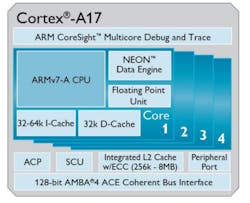32-bit ARM Core Targets Midrange Mobile Devices
ARM's latest 32-bit Cortex-A17 (Fig. 1) targets the midrange mobile device space and it supports ARM's big.LITTLE combo with the Cortex-A7 (see Little Core Shares Big Core Architecture) as well as ARM's Mali graphics support. This latest platform address the same space as the earlier Cortex-A12 (see ARM Fills In Midrange With Cortex-A12). It delivers an additional 60% performance boost compared to the Cortex-A9. It will be available in 2015.
This file type includes high resolution graphics and schematics when applicapable.
Related Articles
- Little Core Shares Big Core Architecture
- ARM Fills In Midrange With Cortex-A12
- Delivering 64-Bit Arm Platforms
- Mobile GPU Architecture Supports Emerging Compression Standard
The Cortex-A17 is built on the ARMv7-A architecture. The 64-bit Cortex-A50 series is based on the ARMv8 architecture (see Delivering 64-Bit Arm Platforms). The 64-bit systems are upward compatible. The ARMv7-A architecture uses an 11+ stage, out-of-order CPU pipeline. It supports ARM's CoreSight trace debugging as well as hypervisor debugging instructions. The Cortex-A17 has VFPv4 floating point support as well as ARM's TrustZone security technology, NEON advanced SIMD support as well as DSP and SIMD enhancements.
The Cortex-A17 is closest to the Cortex-A12 in design and performance. The biggest difference is the Cortex-A17's support for big.LITTLE. Systems with one to four Cortex-A17 cores are possible. The system has a low-latency L2 cache and cores are tied together using a high-bandwidth AMBA 4 ACE Coherent Bus. Initial implementations of 2 GHz Cortex-A17 are expected to using 28-nm technology while moving to 20-nm.
The Cortex-A17 can be paired with third party graphics and GPU support but it can also be integrated with ARM's Mali options including the Mali-T720 GPU, Mali-V5000 and Mali-DP500 Display support. The Mali-T720 GPU supports the Khronos Group's Adaptive Scalable Texture Compress (ASTC) the reduces data size (see Khronos Releases ASTC Next-Generation Texture Compression Specification). The Cortex-A17 is also supported by ARM's Processor Optimization Pack (POP) IP.
About the Author
William G. Wong
Senior Content Director - Electronic Design and Microwaves & RF
I am Editor of Electronic Design focusing on embedded, software, and systems. As Senior Content Director, I also manage Microwaves & RF and I work with a great team of editors to provide engineers, programmers, developers and technical managers with interesting and useful articles and videos on a regular basis. Check out our free newsletters to see the latest content.
You can send press releases for new products for possible coverage on the website. I am also interested in receiving contributed articles for publishing on our website. Use our template and send to me along with a signed release form.
Check out my blog, AltEmbedded on Electronic Design, as well as his latest articles on this site that are listed below.
You can visit my social media via these links:
- AltEmbedded on Electronic Design
- Bill Wong on Facebook
- @AltEmbedded on Twitter
- Bill Wong on LinkedIn
I earned a Bachelor of Electrical Engineering at the Georgia Institute of Technology and a Masters in Computer Science from Rutgers University. I still do a bit of programming using everything from C and C++ to Rust and Ada/SPARK. I do a bit of PHP programming for Drupal websites. I have posted a few Drupal modules.
I still get a hand on software and electronic hardware. Some of this can be found on our Kit Close-Up video series. You can also see me on many of our TechXchange Talk videos. I am interested in a range of projects from robotics to artificial intelligence.



